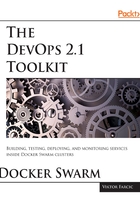
Setting Up and Operating a Swarm Cluster
–M.Conway
Many will tell you that they have a scalable system. After all, scaling is easy. Buy a server, install WebLogic (or whichever other monster application server you're using) and deploy your applications. Then wait for a few weeks until you discover that everything is so fast that you can click a button, have some coffee, and, by the time you get back to your desk, the result will be waiting for you. What do you do? You scale. You buy a few more servers, install your monster application servers and deploy your monster applications on top of them. Which part of the system was the bottleneck? Nobody knows. Why did you duplicate everything? Because you must. And then some more time passes, and you continue scaling until you run out of money and, simultaneously, people working for you go crazy. Today we do not approach scaling like that. Today we understand that scaling is about many other things. It's about elasticity. It's about being able to quickly and easily scale and de-scale depending on variations in your traffic and growth of your business, and that you should not go bankrupt during the process. It's about the need of almost every company to scale their business without thinking that IT department is a liability. It's about getting rid of those monsters.
The text that follows is identical to the one published in The DevOps 2.0 Toolkit. If it is still fresh in your mind, feel free to jump to the section Docker Swarm Mode of this chapter. You'll see that a lot has changed. One of those changes is that the old Swarm running as a separate container is deprecated for Swarm Mode. There are many other new things we'll discover along the way.